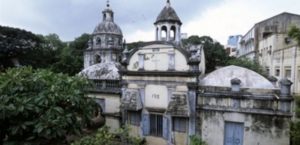 CHENNAI, India (Times of India) — The Armenian church in Chennai, built in 1712, has weathered many a storm in the last 300 years, but cyclone Vardah managed to leave its mark on this landmark monument in Chennai, the Times of India reports.
CHENNAI, India (Times of India) — The Armenian church in Chennai, built in 1712, has weathered many a storm in the last 300 years, but cyclone Vardah managed to leave its mark on this landmark monument in Chennai, the Times of India reports.
With insufficient funds and lack of public interest, certain portions of the church such as its famous bell tower, housing 26-inch wide bells, overhead pews and wooden rafters — built with Burmese wood — need massive repair. These portions have been cordoned off for the general public as they are unsafe for use.
In the last few decades, services have become a rarity in the 304-year-old church with mass being served only on Christmas by a high priest, who comes down from the Armenian Apostolic Church in Kolkata. “This is one of Chennai’s most beautiful and unique institutions. When the cyclone hit, we lost a lot of ancient trees. The woodwork has weakened and the plaster is falling off in places,” said Jude Johnson, caretaker of the Armenian church aka Church of Holy Virgin Mother Mary.
The church, which is opened for tourists, from 9 a.m. to 2 p.m. every day, is nestled in the busy hub of Parrys. The Armenian Street — named after the church — has banks, corporate establishments, schools, shops, eateries, clothing retailers and a host of other establishments. Yet visitors to the church number few and far between.
“Once in a while, we get Armenian families, who have heard about the church. But weeks can go by without us seeing anyone. For them the attraction is tracing their ancestors. The church’s flagstones are inlaid with the graves of about 350 Armenians. For the Armenians, death was as much a part of life and they did not believe in erecting separate graveyards. The stone epitaphs also bear testament to the lives of Armenian merchants, being embedded with grapes, quills, grain, ships, etc.,” said Johnson.
Chennai, which has always been a melting pot of cultures, has a richness of culture and value systems unrivalled by other cities. The city has its own rich blend of mosques, rubbing shoulders with temples and churches. But while the city’s Roman Catholic, Protestant, Syriac, Mar Thoma churches, and other denominations see a steady stream of church attendants and visitors — for instance St. Mary’s Church, St. Thomas Basilica, Kurks and St. George’s Cathedral — the Armenian church is solitary in its inclusiveness.








